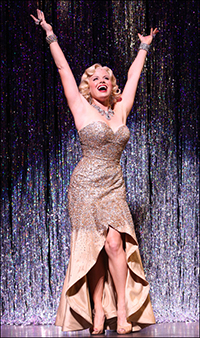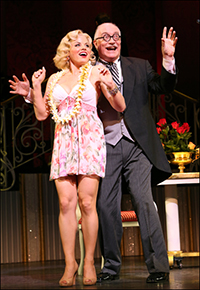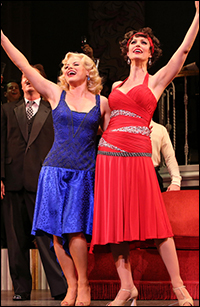
*
Gentlemen Prefer Blondes [Masterworks Broadway]
City Center Encores! had one of their sprightliest outings last May when they brought us Jule Styne and Leo Robin's Gentlemen Prefer Blondes. This 1949 musical was the last of its kind, or at least the last smash hit of its kind — its kind being an old-fashioned laff-fest with girls and gags and real honest-to-goodness tunes. Plus a low-comedy star performance by an unexpectedly uproarious newcomer as adept as Bert Lahr, Bea Lillie and others of that ilk.
Audiences who had moved on to Carousel, Brigadoon, South Pacific and Kiss Me, Kate were nevertheless happy to throng to the Ziegfeld to see this new outlandish clown with those google-eyes — back in the days when google had an altogether different connotation — bedecked in Tiffany's best, who went by the name Carol Channing. A jolly time was had by all, and Robin's song-title "Diamonds Are a Girl's Best Friend" became part of the vernacular.
But Gentlemen Prefer Blondes was the end of the line. This was a lavish affair of the sort the long-dead Ziegfeld himself used to offer. Except that Blondes was a far better show, with a far better score, than Flo's typical musical comedies. This mid-century musical harked back to pre-Depression days, with a massive set, expensive costumes, a full chorus, and a full corps of dancers. Plus two tap specialists and six showgirls. (Yes, they were billed as showgirls in the Playbill.) There were to be later attempts at this sort of extravaganza, but none of them proved as durable or as successful.
What made Gentlemen Prefer Blondes so special — along with the performance of Carol Channing and the durable plot derived from Anita Loos' satirical novel (which she had already adapted successfully as a play and movie) — was the score by Jule Styne and Leo Robin. Styne was a Hollywood tunesmith at the time, with his Broadway experience consisting of one long-running but not quite impressive musical, High Button Shoes. Lyricist Leo Robin had left town for Hollywood long before, but he did have one major Broadway credit in the 1927 Vincent Youmans musical Hit the Deck (which featured the song hit "Hallelujah!"). While Robin is pretty much forgotten today, he came to Blondes with as strong a catalog as Styne, led by such hits as "Beyond the Blue Horizon," "Louise," and "Thanks for the Memory." For Blondes, this one-show-only team came up with a strong assortment of songs. While we expect irrepressible tunes from Styne, the surprise here is just how good Robin's comedy lyrics are. "Diamonds Are a Girl's Best Friend" is justly familiar, but "Just a Little Girl from Little Rock" is a true gem. "Bye Bye Baby," "You Say You Care" and "It's Delightful Down in Chile," are among the other delights.
Visit PlaybillStore.com to view theatre-related recordings for sale.
| |
 |
|
| Megan Hilty | ||
| photo by Joan Marcus |
This has left the musical — despite its better-than-average material — as something of an orphan. Lorelei has twice brought her diamonds back to Broadway, with drastically diminished returns. First, Channing — in search of something to do after a decade in Hello, Dolly! — returned to the role in 1974. At the age of 53. This resulted in a significant amount of rewriting; some necessary, some unwise, and all damaging. Lorelei, they called it, at the Palace. Matters worked out even less well in 1995, when a (good) summer stock production from the Goodspeed Opera House was inappropriately transferred to the Lyceum.
And so Gentlemen Prefer Blondes was consigned to the shadows, with an unfair stigma of being too old-fashioned and too creaky for modern-day comfort. Not so, it turned out. Thus it was that the show received near-unanimous hosannas when after 60 years it frolicked its way onto the City Center stage. They don't write 'em like that anymore, was the popular sentiment. And yes: they don't write 'em like that, indeed.
| |
 |
|
| Megan Hilty and Simon Jones | ||
| Photo by Joan Marcus |
The Encores production of Gentlemen Prefer Blondes is now brought to us by Masterworks Broadway, and it is in fine form. The music sounds great. Don Walker's orchestrations, which are present but diminished on the 1949 original cast album, are now very much audible and guess what? They sound terrific, with music director Rob Berman and the Encores! orchestra giving full value Visit PlaybillStore.com to view theatre-related recordings for sale.
| |
 |
|
| Megan Hilty and Rachel York | ||
| photo by Joan Marcus |
This is not merely a lost art; in Blondes, Martin had 16 singers at his disposal, allowing him to write in eight-part harmony with each part doubled. A Broadway musical with 16 full-time singers, mind you, usually had an equal complement of 12 or 16 full-time dancers; for Blondes, de Mille negotiated for 22. Within a dozen years, musicals started employing what we refer to as dancer/singers; the stronger the dance needs, the less likely you were to have people who could sing intricate eight-part vocals. Today you're lucky to get an ensemble of 16, altogether.
So yes, everything sounds fabulous on the new CD, with strong performances contributed by Rachel York as Dorothy Shaw, the girl who loves what she's doing when she's doing it for love; Aaron Lazar as the sheltered Philadelphia millionaire Henry Spofford (singing the love ballads); Clarke Thorell (now playing Rooster in Annie on Broadway) as Lorelei's fiancée, Mr. Esmond; Stephen R. Buntrock as button king Josephus Gage; and Simon Jones as Sir Francis Beekman, who doesn't — ultimately — get to take Lorelei down to Chile.
But there is a weak link, and a big one. Ms. Hilty got through the stage production very nicely, thank you; but the recording exposes the fact that while Carol Channing was Lorelei Lee — and Marilyn Monroe, in her own way, also was Lorelei Lee — Megan Hilty is merely playing a role. Larger than life is what Lorelei needs to be in order to cause the whole Gentlemen Prefer Blondes soufflé to rise, and Hilty doesn't quite fill Lorelei's costumes. She also doesn't seem to understand the nature of the humor. It has nothing to do with stardom; Hilty came to Encores! as a TV celebrity (NBC's "Smash"), while Carol was relatively unknown when she took the stage in 1949. Consider "Little Girl from Little Rock" and "Diamonds," both of which were written with built-in encores. Hilty more or less earned said encores on stage at Encores!, but listening to the CD you wonder why she is back on the next track, still singing.
So here we have a new, state-of-the-art and musically impeccable recording of Gentlemen Prefer Blondes, and it is highly entertaining and most welcome. But Gentlemen Prefer Blondes without boffo perfs of "Diamonds" and "Little Rock" is not quite what we hoped for. Visit PlaybillStore.com to view theatre-related recordings for sale.
(Steven Suskin is author of "Show Tunes" as well as "The Sound of Broadway Music: A Book of Orchestrators and Orchestrations," "Second Act Trouble," the "Broadway Yearbook" series and the "Opening Night on Broadway" books. He also pens Playbill.com's Book Shelf and DVD Shelf columns. He can be reached at [email protected].)










